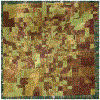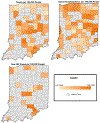Characterising communities impacted by the 2015 Indiana HIV outbreak: A big data analysis of social media messages associated with HIV and substance abuse
- PMID: 32406155
- PMCID: PMC8533051
- DOI: 10.1111/dar.13091
Characterising communities impacted by the 2015 Indiana HIV outbreak: A big data analysis of social media messages associated with HIV and substance abuse
Abstract
Introduction and aims: Infoveillance approaches (i.e. surveillance methods using online content) that leverage big data can provide new insights about infectious disease outbreaks and substance use disorder topics. We assessed social media messages about HIV, opioid use and injection drug use in order to understand how unstructured data can prepare public health practitioners for response to future outbreaks.
Design and methods: We conducted an retrospective analysis of Twitter messages during the 2015 HIV Indiana outbreak using machine learning, statistical and geospatial analysis to examine the transition between opioid prescription drug abuse to heroin injection use and finally HIV transmission risk, and to test possible associations with disease burden and demographic variables in Indiana and Marion County. Tweets from October 2014 to June 2015 were compared to disease burden at the county level for Indiana, and classification of census blocks by presence of relevant messages was done at the census block level for Marion County. Marion County was used as it exhibited the highest total count of Tweets.
Results: 257 messages about substance abuse and HIV were significantly related to HIV rates (P < 0.001) and opioid-related hospitalisations (P = 0.037). Using 157 characteristics from the American Community Survey, a linear classifier was computed with an appreciable correlation (r = 0.49) to risk-related social media messages from Marion County.
Discussion and conclusions: Communities appear to communicate online in response to disease burden. Classification produced an accurate equation to model census block risk based on census data, allowing for high-dimensional estimation of risk for blocks with sparse populations.
Keywords: acquired immunodeficiency syndrome; ecological epidemiology; geospatial analysis; human immunodeficiency virus; social media.
© 2020 Australasian Professional Society on Alcohol and other Drugs.
Conflict of interest statement
Conflict of Interest
The authors have no conflicts of interest.
Figures


Similar articles
-
Identification and characterization of tweets related to the 2015 Indiana HIV outbreak: A retrospective infoveillance study.PLoS One. 2020 Aug 26;15(8):e0235150. doi: 10.1371/journal.pone.0235150. eCollection 2020. PLoS One. 2020. PMID: 32845882 Free PMC article.
-
Machine Learning and Natural Language Processing for Geolocation-Centric Monitoring and Characterization of Opioid-Related Social Media Chatter.JAMA Netw Open. 2019 Nov 1;2(11):e1914672. doi: 10.1001/jamanetworkopen.2019.14672. JAMA Netw Open. 2019. PMID: 31693125 Free PMC article.
-
Opioid Discussion in the Twittersphere.Subst Use Misuse. 2018 Nov 10;53(13):2132-2139. doi: 10.1080/10826084.2018.1458319. Epub 2018 Apr 16. Subst Use Misuse. 2018. PMID: 29659320 Free PMC article.
-
HIV Transmission and Injection Drug Use: Lessons From the Indiana Outbreak.Top Antivir Med. 2016 Jul/Aug;24(2):90-92. Top Antivir Med. 2016. PMID: 27841978 Free PMC article. Review.
-
Methodological approaches for the prediction of opioid use-related epidemics in the United States: a narrative review and cross-disciplinary call to action.Transl Res. 2021 Aug;234:88-113. doi: 10.1016/j.trsl.2021.03.018. Epub 2021 Mar 31. Transl Res. 2021. PMID: 33798764 Free PMC article. Review.
Cited by
-
Utilization of Social Media for the Prevention and Control of HIV/AIDS: A Scoping Review.J Multidiscip Healthc. 2024 May 21;17:2443-2458. doi: 10.2147/JMDH.S465905. eCollection 2024. J Multidiscip Healthc. 2024. PMID: 38799010 Free PMC article.
-
The evolution of Big Data in neuroscience and neurology.J Big Data. 2023;10(1):116. doi: 10.1186/s40537-023-00751-2. Epub 2023 Jul 10. J Big Data. 2023. PMID: 37441339 Free PMC article.
-
Digital Public Health Surveillance Tools for Alcohol Use and HIV Risk Behaviors.AIDS Behav. 2021 Dec;25(Suppl 3):333-338. doi: 10.1007/s10461-021-03221-z. Epub 2021 Mar 17. AIDS Behav. 2021. PMID: 33730254 Free PMC article.
-
Characterizing Self-Reported Tobacco, Vaping, and Marijuana-Related Tweets Geolocated for California College Campuses.Front Public Health. 2021 Apr 13;9:628812. doi: 10.3389/fpubh.2021.628812. eCollection 2021. Front Public Health. 2021. PMID: 33928062 Free PMC article.
-
Digital Epidemiological Approaches in HIV Research: a Scoping Methodological Review.Curr HIV/AIDS Rep. 2023 Dec;20(6):470-480. doi: 10.1007/s11904-023-00673-x. Epub 2023 Nov 2. Curr HIV/AIDS Rep. 2023. PMID: 37917386 Free PMC article.
References
-
- Peters PJ, Pontones P, Hoover KW et al. HIV infection linked to injection use of oxymorphone in Indiana, 2014–2015. N Engl J Med 2016; 375:229–39. - PubMed
-
- Jarlais DCD, Nugent A, Solberg A, Feelemyer J, Mermin J, Holtzman D. Syringe service programs for persons who inject drugs in urban, suburban, and rural areas—United States, 2013. MMWR Morb Mortal Wkly Rep 2015;64:1337–41. - PubMed

